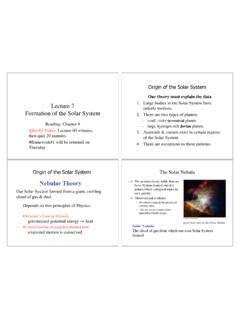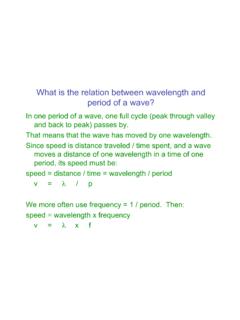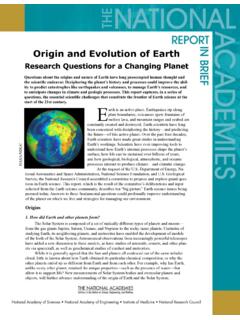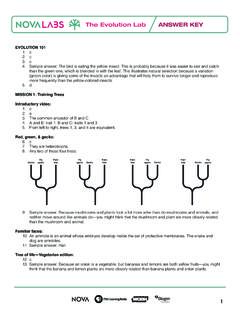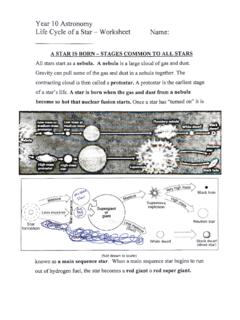Transcription of The Origin and Evolution of Life on Earth
1 AST 309part 2:Extraterrestrial LifeThe Origin and Evolution of life on EarthOverview The formation of Earth Pre-biotic chemistry (Miller-Urey exp.) First evidence for early life The Evolution of life Extreme life on Earth : lessons for astrobiologyA timeline for the very early history of the EarthThe formation of Earth :The Earth formed over ~50 Myr via planetesimal accretionEarth differentiation:Early Earth heats up due to radio-active decay, compression, andimpacts. Over time the temperature ofthe planet interior rises towards the Fe-melting iron "drops" follow gravity andaccumulate towards the core.
2 Lightermaterials, such as silicate minerals,migrate upwards in exchange. These silicate-rich materials may well have risen to the surface in molten form, giving rise to an initial magma ocean After the initial segregation into a central iron (+nickel) core and an outersilicate shell, further differentiation occurred into an inner (solid) and outer(liquid) core (a pressure effect: solid iron is more densely packed than liquidiron), the mantel (Fe+Mg silicates) and the crust (K+Na silicates). Initiallylarge portions of the crust might have been molten - the so called magmaocean. The latter would have cooled to form a layer of basaltic crust (such asis present beneath the oceans today).
3 Continental crust would have formedlater. It is probable that the Earth s initial crust was remelted several timesdue to impacts with large formation of Earth :After condensation of water vapor produced the Earth 's oceans, thussweeping out the carbon dioxide and locking it up into rocks, ouratmosphere was mostly of water by icy planetesimals and comets?Kaboom! The formation of the Moon:Currently favored hypothesis: Earth has a gigantic grazingcollision with a Mars-sizeprotoplanet!It explains the Moon s lower density,lack of iron and oxygen isotope ratiosthat are identical to Earth s (Apollo).
4 A timeline for the very early history of the EarthIn order to be able to find life outside our Earth , we have tounderstand life in our own planet. The chemistry of life and thedifferent processes during the formation and Evolution of theEarth have played a crucial life on Earth a very special thing ?Can life spawn spontaneously elsewhere ?Tiny zircons (zirconium silicate crystals) found in ancient stream deposits indicate thatEarth developed continents and water -- perhaps even oceans and environments inwhich microbial life could emerge -- billion to billion years ago, remarkably soonafter our planet formed.
5 The presence of water on the young Earth was confirmed whenthe zircons were analyzed for oxygen isotopes and the telltale signature of rocks thathave been touched by water was found: an elevated ratio of oxygen-18 to timeline for the very early history of the EarthHow to understand an astrobiologist (or anymicrobiologist):Monomer: usually a small molecule that can bind chemically to form apolymer (amino acids are monomers)Polymer: a macro-molecule composed of repeating structural units. Proteinsand nucleoacids (RNA & DNA) are polymersProtein: a biochemical compound that facilitates a biological functionEncyme: are proteins that catalyze ( increase rates) of chemical reactionsRNA: Ribonucleic acid, a macromolecule made of long chains of nucleotides (1base, 1 sugar and a phosphate group).
6 Single strand, can carrygenetic : Deoxyribonucleic acid, double-helix shaped macromolecule made ofnucleotides. Carries genetic Miller-Urey experimentIn the 1930s, Oparin and Haldane independently suggestedthat ultraviolet radiation from the sun or lightning dischargescaused the molecules of the primordial atmosphere to react toform simple organic (carbon-containing) compounds. Thisprocess was replicated in 1953 by Stanley Miller and HaroldUrey, who subjected a mixture of H2O, CH4, NH3, and H2 to anelectric discharge for about a week. The resulting solutioncontained water-soluble organic compounds, including severalamino acids (which are components of proteins) and otherbiochemically significant experiments only give large yields of interestingorganics (amino acids, nucleic acids, sugars) if the gas isH-rich (highly reducing).
7 If the early atmosphere was CO2+ N2 (mildly reducing), as many suspect, the yields : The assumed atmospheric compositionAtmosphere fromvolcanic outgassing?This would give atmosphererich in CO2, N2, and the composition thatfavors Miller-Urey the original atmosphere have been delivered to the Earth fromcomets, asteroids, ..? Perhaps then the composition would be was the source of the early Earth s atmosphere? Not necessarily endogenous (there from thestart). Outgassing from the crust due to volcanoes (top two), or planetesimal impact (lower left), orcomet vaporization (lower right)?
8 The point here is that a major alternative is exogenous delivery oforganics by comets, asteroids, interplanetary alternative: irradiation of ices,either extraterrestrial, or on a cold young EarthSeveral groups have produced amino acids and other biologically-interesting molecules byultraviolet irradiation of ices meant to resemble what we think interstellar icesare like. Munoz Caro et al. (2002) produced 16 amino acids this way. Hudson et al. (2008) et showed that irradiation of ice with high-energy protons produces amino acids, withoutany other gases present ( doesn t depend on having hydrogen-rich key compound in the ices: Nitriles.)
9 In these experiments, it was acetonitrileYou may remember it from the amino acid-like molecule discovered in the interstellarmedium: CH3CN. It is also detected in comets and in Titan s condensation of water vapor produced the Earth 's oceans, thussweeping out the carbon dioxide and locking it up into rocks, ouratmosphere was mostly amino acids have a mirror image (L and D): L and D both found in meteorites L only in organisms on the earthwhy is D selected against?(*)So now we have some amino acids (monomers) loosely mixed in theoceans. Liquid medium is important: Protects molecules from UV photon disruption Ease of transport and InteractionNext goal is to combine Monomers into Polymers (peptide chains)(*) We believe that Earth life 's "choice" of chirality was purely random, andthat if carbon-based life forms exist elsewhere in the universe, their chemistrycould theoretically have opposite monomer?
10 Which polymer? Monomers (building blocks) polymerized into four types of , only two types seem crucial for primitive biological processes: amino acids/proteins and nucleotides/nucleic acidsDNA-protein system: Too complex for !rst lifeSo which came !rst? The chicken and the egg problem is obvious: Neither DNA norprotein has any function without the other. Yet their symbiosis is fartoo complex to have arisen from nothing. => So what preceded the DNA/protein system?This protein is bendingpart of a DNA, somethingDNA is too stiff to do onits own. There aremyriad other DNA-protein interactions, of DNA is a temptation to think of life " as a protein-making gene system.


